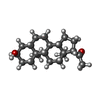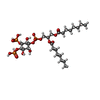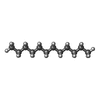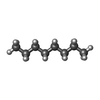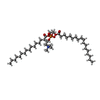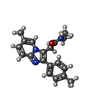[English] 日本語
 Yorodumi
Yorodumi- EMDB-29727: Native GABA-A receptor from the mouse brain, alpha1-beta2-gamma2 ... -
+ Open data
Open data
- Basic information
Basic information
| Entry |  | |||||||||
|---|---|---|---|---|---|---|---|---|---|---|
| Title | Native GABA-A receptor from the mouse brain, alpha1-beta2-gamma2 subtype, in complex with GABA, Zolpidem, and endogenous neurosteroids | |||||||||
 Map data Map data | Native GABA receptor in complex with 8E3-Fab, Zolpidem, and endogenous neurosteroids | |||||||||
 Sample Sample |
| |||||||||
 Keywords Keywords | ligand-gated ion channel / cys-loop receptor / neurotransmitter receptor / MEMBRANE PROTEIN | |||||||||
| Function / homology |  Function and homology information Function and homology informationGABA receptor activation / inhibitory extracellular ligand-gated monoatomic ion channel activity / diazepam binding / inhibitory synapse / GABA receptor complex / organic cyclic compound binding / inner ear receptor cell development / cellular response to histamine / GABA-A receptor activity / GABA-gated chloride ion channel activity ...GABA receptor activation / inhibitory extracellular ligand-gated monoatomic ion channel activity / diazepam binding / inhibitory synapse / GABA receptor complex / organic cyclic compound binding / inner ear receptor cell development / cellular response to histamine / GABA-A receptor activity / GABA-gated chloride ion channel activity / GABA-A receptor complex / inhibitory synapse assembly / innervation / synaptic transmission, GABAergic / gamma-aminobutyric acid signaling pathway / postsynaptic specialization membrane / neurotransmitter receptor activity / chloride channel activity / cochlea development / adult behavior / chloride channel complex / regulation of postsynaptic membrane potential / transmembrane transporter complex / neuron development / GABA-ergic synapse / presynaptic active zone membrane / chloride transmembrane transport / dendrite membrane / ligand-gated monoatomic ion channel activity involved in regulation of presynaptic membrane potential / post-embryonic development / transmitter-gated monoatomic ion channel activity involved in regulation of postsynaptic membrane potential / cytoplasmic vesicle membrane / cytoplasmic vesicle / chemical synaptic transmission / postsynapse / neuron projection / axon / glutamatergic synapse / synapse / plasma membrane Similarity search - Function | |||||||||
| Biological species |  | |||||||||
| Method | single particle reconstruction / cryo EM / Resolution: 2.67 Å | |||||||||
 Authors Authors | Sun C / Gouaux E | |||||||||
| Funding support |  United States, 2 items United States, 2 items
| |||||||||
 Citation Citation |  Journal: Nature / Year: 2023 Journal: Nature / Year: 2023Title: Cryo-EM structures reveal native GABA receptor assemblies and pharmacology. Authors: Chang Sun / Hongtao Zhu / Sarah Clark / Eric Gouaux /   Abstract: Type A γ-aminobutyric acid receptors (GABARs) are the principal inhibitory receptors in the brain and the target of a wide range of clinical agents, including anaesthetics, sedatives, hypnotics and ...Type A γ-aminobutyric acid receptors (GABARs) are the principal inhibitory receptors in the brain and the target of a wide range of clinical agents, including anaesthetics, sedatives, hypnotics and antidepressants. However, our understanding of GABAR pharmacology has been hindered by the vast number of pentameric assemblies that can be derived from 19 different subunits and the lack of structural knowledge of clinically relevant receptors. Here, we isolate native murine GABAR assemblies containing the widely expressed α1 subunit and elucidate their structures in complex with drugs used to treat insomnia (zolpidem (ZOL) and flurazepam) and postpartum depression (the neurosteroid allopregnanolone (APG)). Using cryo-electron microscopy (cryo-EM) analysis and single-molecule photobleaching experiments, we uncover three major structural populations in the brain: the canonical α1β2γ2 receptor containing two α1 subunits, and two assemblies containing one α1 and either an α2 or α3 subunit, in which the single α1-containing receptors feature a more compact arrangement between the transmembrane and extracellular domains. Interestingly, APG is bound at the transmembrane α/β subunit interface, even when not added to the sample, revealing an important role for endogenous neurosteroids in modulating native GABARs. Together with structurally engaged lipids, neurosteroids produce global conformational changes throughout the receptor that modify the ion channel pore and the binding sites for GABA and insomnia medications. Our data reveal the major α1-containing GABAR assemblies, bound with endogenous neurosteroid, thus defining a structural landscape from which subtype-specific drugs can be developed. | |||||||||
| History |
|
- Structure visualization
Structure visualization
| Supplemental images |
|---|
- Downloads & links
Downloads & links
-EMDB archive
| Map data |  emd_29727.map.gz emd_29727.map.gz | 86.2 MB |  EMDB map data format EMDB map data format | |
|---|---|---|---|---|
| Header (meta data) |  emd-29727-v30.xml emd-29727-v30.xml emd-29727.xml emd-29727.xml | 23.7 KB 23.7 KB | Display Display |  EMDB header EMDB header |
| FSC (resolution estimation) |  emd_29727_fsc.xml emd_29727_fsc.xml | 11.9 KB | Display |  FSC data file FSC data file |
| Images |  emd_29727.png emd_29727.png | 174.9 KB | ||
| Masks |  emd_29727_msk_1.map emd_29727_msk_1.map | 178 MB |  Mask map Mask map | |
| Filedesc metadata |  emd-29727.cif.gz emd-29727.cif.gz | 7.9 KB | ||
| Others |  emd_29727_half_map_1.map.gz emd_29727_half_map_1.map.gz emd_29727_half_map_2.map.gz emd_29727_half_map_2.map.gz | 165.3 MB 165.3 MB | ||
| Archive directory |  http://ftp.pdbj.org/pub/emdb/structures/EMD-29727 http://ftp.pdbj.org/pub/emdb/structures/EMD-29727 ftp://ftp.pdbj.org/pub/emdb/structures/EMD-29727 ftp://ftp.pdbj.org/pub/emdb/structures/EMD-29727 | HTTPS FTP |
-Validation report
| Summary document |  emd_29727_validation.pdf.gz emd_29727_validation.pdf.gz | 1.2 MB | Display |  EMDB validaton report EMDB validaton report |
|---|---|---|---|---|
| Full document |  emd_29727_full_validation.pdf.gz emd_29727_full_validation.pdf.gz | 1.2 MB | Display | |
| Data in XML |  emd_29727_validation.xml.gz emd_29727_validation.xml.gz | 20.9 KB | Display | |
| Data in CIF |  emd_29727_validation.cif.gz emd_29727_validation.cif.gz | 27 KB | Display | |
| Arichive directory |  https://ftp.pdbj.org/pub/emdb/validation_reports/EMD-29727 https://ftp.pdbj.org/pub/emdb/validation_reports/EMD-29727 ftp://ftp.pdbj.org/pub/emdb/validation_reports/EMD-29727 ftp://ftp.pdbj.org/pub/emdb/validation_reports/EMD-29727 | HTTPS FTP |
-Related structure data
| Related structure data |  8g4nMC  8foiC  8g4oC  8g4xC  8g5fC  8g5gC  8g5hC M: atomic model generated by this map C: citing same article ( |
|---|---|
| Similar structure data | Similarity search - Function & homology  F&H Search F&H Search |
- Links
Links
| EMDB pages |  EMDB (EBI/PDBe) / EMDB (EBI/PDBe) /  EMDataResource EMDataResource |
|---|---|
| Related items in Molecule of the Month |
- Map
Map
| File |  Download / File: emd_29727.map.gz / Format: CCP4 / Size: 178 MB / Type: IMAGE STORED AS FLOATING POINT NUMBER (4 BYTES) Download / File: emd_29727.map.gz / Format: CCP4 / Size: 178 MB / Type: IMAGE STORED AS FLOATING POINT NUMBER (4 BYTES) | ||||||||||||||||||||||||||||||||||||
|---|---|---|---|---|---|---|---|---|---|---|---|---|---|---|---|---|---|---|---|---|---|---|---|---|---|---|---|---|---|---|---|---|---|---|---|---|---|
| Annotation | Native GABA receptor in complex with 8E3-Fab, Zolpidem, and endogenous neurosteroids | ||||||||||||||||||||||||||||||||||||
| Projections & slices | Image control
Images are generated by Spider. | ||||||||||||||||||||||||||||||||||||
| Voxel size | X=Y=Z: 0.826 Å | ||||||||||||||||||||||||||||||||||||
| Density |
| ||||||||||||||||||||||||||||||||||||
| Symmetry | Space group: 1 | ||||||||||||||||||||||||||||||||||||
| Details | EMDB XML:
|
-Supplemental data
-Mask #1
| File |  emd_29727_msk_1.map emd_29727_msk_1.map | ||||||||||||
|---|---|---|---|---|---|---|---|---|---|---|---|---|---|
| Projections & Slices |
| ||||||||||||
| Density Histograms |
-Half map: #1
| File | emd_29727_half_map_1.map | ||||||||||||
|---|---|---|---|---|---|---|---|---|---|---|---|---|---|
| Projections & Slices |
| ||||||||||||
| Density Histograms |
-Half map: #2
| File | emd_29727_half_map_2.map | ||||||||||||
|---|---|---|---|---|---|---|---|---|---|---|---|---|---|
| Projections & Slices |
| ||||||||||||
| Density Histograms |
- Sample components
Sample components
+Entire : Native GABAA Receptor isolated from mouse brain containing two al...
+Supramolecule #1: Native GABAA Receptor isolated from mouse brain containing two al...
+Macromolecule #1: Gamma-aminobutyric acid receptor subunit alpha-1
+Macromolecule #2: Gamma-aminobutyric acid receptor subunit beta-2
+Macromolecule #3: Gamma-aminobutyric acid receptor subunit gamma-2
+Macromolecule #4: Heavy Chain of 8E3 Fab
+Macromolecule #5: Light Chain of 8E3 Fab
+Macromolecule #9: allopregnanolone
+Macromolecule #10: [(2R)-2-octanoyloxy-3-[oxidanyl-[(1R,2R,3S,4R,5R,6S)-2,3,6-tris(o...
+Macromolecule #11: DODECANE
+Macromolecule #12: N-OCTANE
+Macromolecule #13: (2S)-3-(hexadecanoyloxy)-2-[(9Z)-octadec-9-enoyloxy]propyl 2-(tri...
+Macromolecule #14: GAMMA-AMINO-BUTANOIC ACID
+Macromolecule #15: Zolpidem
+Macromolecule #16: 2-acetamido-2-deoxy-beta-D-glucopyranose
-Experimental details
-Structure determination
| Method | cryo EM |
|---|---|
 Processing Processing | single particle reconstruction |
| Aggregation state | particle |
- Sample preparation
Sample preparation
| Concentration | 0.1 mg/mL | |||||||||
|---|---|---|---|---|---|---|---|---|---|---|
| Buffer | pH: 8 Component:
| |||||||||
| Grid | Model: Quantifoil R2/1 / Material: GOLD / Mesh: 200 / Support film - Material: CARBON / Support film - topology: CONTINUOUS / Support film - Film thickness: 2 / Pretreatment - Type: GLOW DISCHARGE / Pretreatment - Time: 45 sec. / Pretreatment - Atmosphere: AIR | |||||||||
| Vitrification | Cryogen name: ETHANE / Chamber humidity: 100 % / Chamber temperature: 293 K / Instrument: FEI VITROBOT MARK IV | |||||||||
| Details | This sample was monodisperse. |
- Electron microscopy
Electron microscopy
| Microscope | FEI TITAN KRIOS |
|---|---|
| Image recording | Film or detector model: GATAN K3 BIOQUANTUM (6k x 4k) / Average electron dose: 50.0 e/Å2 |
| Electron beam | Acceleration voltage: 300 kV / Electron source:  FIELD EMISSION GUN FIELD EMISSION GUN |
| Electron optics | Illumination mode: FLOOD BEAM / Imaging mode: BRIGHT FIELD / Nominal defocus max: 2.1 µm / Nominal defocus min: 0.8 µm |
| Experimental equipment |  Model: Titan Krios / Image courtesy: FEI Company |
+ Image processing
Image processing
-Atomic model buiding 1
| Refinement | Space: REAL / Protocol: AB INITIO MODEL |
|---|---|
| Output model |  PDB-8g4n: |
 Movie
Movie Controller
Controller


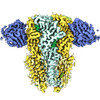








 Z (Sec.)
Z (Sec.) Y (Row.)
Y (Row.) X (Col.)
X (Col.)













































